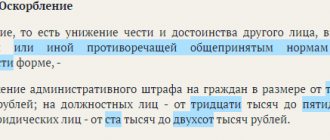Home • Blog • Product labeling • Product labeling: inspections and fines
November 17, 2021
792
There are fines for failure to label goods. Their sizes are determined by Art. 15.12 Code of Administrative Offenses of the Russian Federation.
Today, tobacco, shoes, medicines and other goods are not sold without identification. From the first day of 2022, the process of labeling light industry, then dairy products began. By 2024, labeling will cover all categories of goods on the Russian market. Increased control over labeling work by government agencies cannot be avoided. In order not to pay fines, you will have to strictly comply with all the norms established by law. Labeling requires inspection by regulatory authorities. More on all this later.
Register of violations in the field of labeling
The processing of information on working with labeled goods is carried out by the CRPT. He is the one appointed as the operator of the marking system. Depending on the direction, work is carried out from different legal entities. But despite this, the responsibility lies specifically with the CRPT company.
Due to the fact that CRPT operates on the principle of public-private partnership, it cannot exercise control over market participants. But it has the right to collect and process data. And Rospotrebnadzor, in turn, has access to such information. It is this body that is responsible for identifying offenders.
The task of Rospotrebnadzor is to verify the data provided by participants in the labeling of goods and compare such information with that available to the Federal Tax Service. If in doubt, entrepreneurs may be required to provide written notice with explanations.
So, the register of violations is compiled by the CRPT, and Rospotrebnadzor, which has access to it, checks the data. Providing access to this register to participants in the turnover will allow conscientious entrepreneurs to respond in a timely manner, correct existing errors and avoid repeated violations.
Objectives of Rospotrebnadzor in the field of labeling
In the area of work in the labeling system, Rospotrebnadzor performs the following main tasks:
- checking the accuracy of the data provided by participants in accordance with the established rules for labeling goods;
- comparison of the information received with the information specified in the primary documentation, accounting reports, contracts, as well as other documents provided by the tax authorities;
- calling participants to give explanations;
- If data on the circulation of labeled goods appears, Rospotrebnadzor must request and receive them, as well as supporting documents from participants within five days.
Due to the spread of coronavirus infection, various restrictions were introduced that affected all areas of business. At the same time, checks on the labeling of goods by Rospotrebnadzor have not been suspended. The register of violations continues to be replenished, and the data is transferred to the regulatory authority.
What problems does business face when labeling?
Integration problems between services
Product labeling has recently been in effect in Russia. Widespread adoption began last year and users initially complained of problems. Alexey Yarkashev, a representative of the Binom store, recalls how tire labeling started:
“It didn't start out very well for us. There were problems integrating 1C with Honest Sign, and we could not remove the tires from circulation. As a result, retail trade simply stopped for 2 weeks. We also labeled the leftovers ourselves. We printed out the codes on plain paper. If these stamps fall off and get lost, additional problems will arise. And this is quite likely, because some tires are sold for 3-4 years.”
Imperfection of codes
Scanners do not always read codes correctly or give an error that there is no such product. He's real though. Also, when returning a product, it can be difficult to return the code to circulation.
In the chats of manufacturers, they often complain that “Honest Sign” is also slow. For example, you need to mark 1000 pairs of sneakers, and the system gives several dozen codes per hour. We have to wait a long time until the entire batch is marked.
One of the problems with marking is the codes themselves. They are applied to goods, but even good paper does not guarantee that they are well secured. Especially in clothing stores. While 10 buyers try on the item, the brand will easily fall off and be lost.
Lack of smooth processes
There are errors that are influenced by the human factor. Yuri Spirin says that wholesalers do not always have the strength to label all goods:
“Sometimes a shipment of sneakers arrives, but there are no codes. We ask what's the matter. The couriers shrug their shoulders and nod to the supplier’s IT department. But the responsibility lies with us, so we don’t accept such a batch and wait for a labeled one.”
In general, product labeling goes through the usual problems of any innovation. When the EGAIS system for alcohol was introduced, there were the same problems. Suppliers initially took a long time to sell off their remaining stock, and after that they gradually began to introduce new alcohol items for sale.
If you are opening a business in which goods need to be labeled, set aside time to test the system. And keep in mind that online cash register or online accounting providers offer clients services for simplified work in the marking system.
What kind of violations can there be?
Of course, the most common violation is the absence of a labeling code on the product. But there are many other situations where labelers, knowingly or unknowingly, violate labeling rules. Let's try to figure it out.
Situation 1. There is no marking code
A common violation is that the marking mark must have been applied to the product packaging, tag or label, or the product itself. If the item or product is not labeled, you will be fined. The fact is that the application rules are established by the marking operator; the code must somehow comply with the rules and requirements of the system.
Situation 2. The marking is applied incorrectly
A common case is that the marking must be clearly visible and easy to read. If this is not the case, then you may also face a fine.
Situation 3. Code information does not correspond to UPD data
When the marking code is broken, the data does not correspond to the actual data. For example, if the document lists other models or other products. Most likely, such goods will be confiscated, and the store will be fined for violation.
Situation 4. The product was not relabeled
When for some reason a product loses its marking code, it should be re-labeled. The same applies to returns from customers without a marking code or if the product was returned with a damaged code. Attempting to resell without relabeling is a violation for which you will definitely receive a fine.
Situation 5. Incorrect return
If you attempt to pass off unmarked remaining product as a return, or if the buyer returns an item that has not yet been marked, the return will be incorrect.
4.Is it realistic to get a fine?
It is very easy to get a fine for violating labeling rules. And even the sign of the “Flowers” store did not become a shield from punishment for the sale of unmarked products. Cigarettes were sold in this flower shop (Resolution of the Yalchik District Court (Chuvash Republic) dated July 30, 2020 No. 5-K-113/2020).
Inspectors often walk through shopping pavilions (Resolution of the Moscow District Court of Cheboksary dated 02/04/2020 No. 5-4/2020 5-467/2019).
And what kind of stories can people come up with if they were caught selling unmarked goods? For example, a salesperson reported that the store owner showed her her workplace, pointing out the need to sell cigarettes only from a display window on the sales floor. At the same time, she independently put cigarettes on display in the sales area, which turned out to be unlabeled, and sold them to customers. The seller noted that she did not distinguish cigarettes that could be sold in the Russian Federation from cigarettes whose circulation was prohibited, so she sold all the cigarettes that were on the sales floor. But this did not help the individual entrepreneur avoid a fine (Resolution of the Bezhanitsky District Court dated January 27, 2020 No. 5-1/2020).
Investigators seized previously purchased unlabeled alcoholic beverages from an individual’s garage. Despite the fact that the court qualified the defendant’s actions under Art. 171.1 part 5 of the Criminal Code of the Russian Federation, he managed to avoid criminal punishment. The court took into account the nature and degree of public danger of the crime, as well as information about the defendant’s personality. The offender was brought to criminal responsibility for the first time, he deeply and sincerely repented of his deed, he works, according to his words, the monthly income is about 25,000 rubles and he has two more adult daughters who are studying at a paid institute. The court's verdict was lenient - a fine of 50,000 rubles (Sentence of the Volgodonsk District Court (Rostov Region) dated 09.09.2020 No. 1-527/2019).
In our next video, we will tell you which products lead in violations of the rules of trade in unlabeled goods and how to avoid fines.
Examples of violations
The greatest difficulties arise in maintaining a logical chain of information about the movement of marked goods. Labeling deadlines were periodically postponed; they differed for certain product groups for manufacturers and retailers. As a result, some companies transferred information about products to the system, while others did not. This led to a break in the logical chains. Let’s say a brand was ordered and put into circulation, but when sold to a counterparty, the latter did not confirm acceptance. Upon subsequent sale of goods marked with this code through the cash register to the end consumer, a violation is registered. After all, the products themselves remained on the balance sheet of the supplier. That is, the counterparty is selling it illegally.
If this happened during the voluntary marking period, the counterparty did not violate anything. According to the law, participation in the experiment is not mandatory, but is optional. Therefore, the CRPT decided to control the logical chain only after the date of introduction of mandatory product labeling.
In addition, the labeling of residues has been extended for certain product groups. That is, unlabeled products may be in circulation for some time. Even storing it is prohibited after the mandatory labeling date. Therefore, Rosselkhoznadzor can draw up a violation protocol if it detects unsold balances. After this, the document is submitted to the court, which imposes a punishment (usually a fine).
Requirements according to Federal Law-54
The rules for working in the labeling system are reflected not only in the Orders and Resolutions of the Government of the Russian Federation. Certain points are regulated in Federal Law No. 54 on the use of cash registers. In particular, the procedure for selling labeled goods through an online cash register is reflected. The generated receipt must contain a special detail - product code. In the printed receipt format, it is represented by the [M] symbol.
If the firmware at the checkout does not allow you to display the details on the receipt, you will have to update it. The cash register may need to be replaced.
One more point: a businessman enters into an agreement with a fiscal data operator. According to it, data on the withdrawal of a labeled product from circulation through its sale to the final consumer is automatically transferred to Chestny Znak. And the responsibility for this transfer lies with the OFD.
What is the marking?
Labeling allows you to control the movement of goods from production to final sale by assigning a special code to each unit of product. Companies participating in the turnover are required to register on the “Honest Sign” portal, where they fill out all the information about the labeled goods, including both primary information and information about movement along the supply chain, about balances, and disposal from circulation.
The labeling process requires preparation, since it is necessary to train employees to work with a new direction, enter data into the “Honest Sign”, and monitor the accuracy of the transmitted information.
The main documents regulating the labeling process are Law 487-FZ of December 31, 2017 and 488-FZ of December 25, 2018. They approved the basic provisions on labeling, trading activities, and approved liability for violations.
It recently became known that legislators have tightened penalties for lack of labeling and for sending incorrect information to the system. More on this below.
Brand accounting is a ready-made solution for stores to work with labeling. Experts will help you register in the “Honest Sign” system. Thanks to the service, you will be able to see analytics on goods, place orders and write off codes, accept goods with labeling codes, and use other features. Tariff - 1,000 rubles per year.
Product labeling: fines
For the absence or violation of the application of identification means, the following types of fines are provided:
- production - up to 10,000 rubles. (for officials), up to 100,000 rubles. (for legal entities);
- sale, transportation and storage - up to 4,000 rubles. (for citizens), up to 10,000 rubles. (for officials), up to 300,000 rubles. (for legal entities);
- incorrect labeling - up to 10,000 rubles. (for individual entrepreneurs), up to 100,000 rub. (for organizations);
- absence of requisites product code (for goods marked on the receipt - for employees up to 3,000 rubles, for individual entrepreneurs and organizations up to 10,000 rubles.
For violation of labeling, manufacturers of alcohol and cigarettes are subject to fines of up to 15,000 rubles. for officials and up to 150,000 rubles. for legal entities. Selling these goods without labeling is punishable by fines of up to 5,000 rubles. for citizens, up to 15,000 rubles. for officials and up to 300,000 rubles. for legal entities.
In all cases, except for an administrative fine, the items of the offense are subject to confiscation. That is, if during an inspection they find goods without means of identification, if they are already subject to mandatory labeling by law, they will simply be confiscated. And the entrepreneur will be fined.
In case of violation of the rules of “trade marking” (for receipts, price tags, etc.), for individual entrepreneurs the fine can be up to 30,000 rubles, and for organizations - up to 300,000 rubles. Moreover, if the violation caused harm to the buyer, the fine will be increased by 3 times.
Fines do not apply during the experiment and during the transition period, when the labeling of goods is carried out on a voluntary basis.
Other changes to standards
- From 2022 there is no requirement to label footwear made by artisans. How to obtain artisan status is determined by regional legislation.
- From January 1, the fine for transporting tobacco products without labeling will increase. Now the maximum fine for this violation is 25,000 rubles. instead of 15,000 rubles.
- The simplified procedure for drug labeling has been extended until February 1. Now it is no longer valid: you need to describe medications in order to receive codes using the full template.
- Samples of perfumes and eau de toilette can be sold without registration. The maximum probe volume was limited. The volume of the bottle should not exceed 3 ml inclusive.
- When describing perfumes and eau de toilette, it is required to convey the HS code consisting of 10, not 4, characters.
Preparing your business to operate under the new rules
To avoid fines, it is necessary to prepare the business in advance to work with product labeling. Manufacturers must equip workplaces with printers for printing marking codes. Retailers are also interested in purchasing this equipment. They also sometimes order and print codes when re-labeling, marking leftovers or accepting products for commission from individuals. Retailers will definitely need two-dimensional barcode scanners to scan stamps from product packaging.
Due to the spread of coronavirus infection, on-site inspections were temporarily prohibited, which was done to preserve the health of citizens and ensure their safety. However, all violations committed during the pandemic do not pass by the regulatory authorities. Information is accumulated in the register, and then it will be transferred to Rosselkhoznadzor.
The statute of limitations for labeling offenses is three months. However, in some cases it can increase to a year. In addition, information in violation registers may be considered an indication of a “continuing offence.” In such cases, the limitation period begins from the last detected case.
It is also worth noting that the operation of the marking system is currently carried out in a mode of regular failures. They cause delays in the transmission of data on labeled products. Such failures may also indicate that the company is violating the rules of operation, and the system is trying to prevent violations.
To record a failure in working with Honest Sign, you need to document it: take a screenshot of the screen (it is important that the date and time are displayed on it), a photo of the dialogue with the support service, letters about access problems, etc.
How a retail store can avoid fines
Business registration
To avoid fines, you should register your business on the Chestny ZNAK website in time. The deadlines for registration of participants in the turnover are known in advance, long before the introduction of labeling for a new category of goods. To register an individual entrepreneur or company, an electronic signature will be required.
Working with an EDF operator
After registering a business, you need to connect to an EDF operator. On the website you can connect to the EDO Light service for free. But this is not mandatory; you can choose any other operator to connect to.
Connecting to EDF allows you to sign electronic documents:
- invoices for payment of goods;
- invoices;
- invoices;
- acts, including reconciliation acts;
- adjustments;
- other documents.
Without connecting to EDI, it will not be possible to transmit information about the acceptance of goods and the sale of wholesale quantities. Failure to transmit data within 3 days after the transaction is a violation.
Acceptance of wholesale quantities
Creation of delivery documents is the responsibility of the supplier. In the electronic invoice, he must indicate the labeling codes for goods from the wholesale batch. The supplier sends the completed invoice to the receiving party through the EDI operator.
The incoming document is displayed in the user’s account on the Chestny ZNAK website. It must be signed to complete the transaction. To avoid fines, check the codes from the invoices with the codes on the goods. After signing the invoice, the goods are transferred to the balance of the new owner.
What the recipient of a wholesale shipment can do:
- Carry out confidential acceptance by signing the invoice without checking.
- Selectively check the labels of several products from the batch.
- Check all labeling codes in the batch. This option is the most reliable, but requires a lot of time.
If the recipient signs the delivery note without checking the codes, he may be fined for providing false information. This will happen if it turns out that the information from the invoice does not match the codes of the shipped goods.
To quickly check codes, use 2D scanners. Look for models with anti-glare technology: Cigarettes and other products may be packaged in clear film that creates interference. Modern scanners quickly read glare labels and unclear codes.
Are criminal penalties possible?
The answers to this question can be easily found in the Criminal Code of the Russian Federation. The answer is not surprising - yes, you can receive criminal punishment for marking, and not just a fine and confiscation. Here we are talking about violations on a particularly large scale. Article 169 of the Criminal Code states that a violation amounting to more than 1.5 million rubles is considered a particularly major violation. But major violations differ for different goods, so for food it is already more than 400 thousand rubles, and for tobacco products it is more than 100 thousand rubles.
One way or another, if a violation for labeling a product is recognized as major, then the culprit will face imprisonment for up to 4 years and a fine of up to 100 thousand rubles with confiscation of the goods. For especially large violations, everything is even worse; here we are talking about 6 years of imprisonment and a fine of up to 500 thousand rubles. They can also be jailed for producing goods without labeling.
Control authorities are not asleep
Please note that supervisory authorities are now actively monitoring participants in the footwear trade for the presence of markings on products. What can they do if violations are discovered? For example, your products may be seized - and the entire batch at once - if it is discovered that they are counterfeit. According to media reports, counterfeit footwear products are found almost every day in various regions of Russia. And this applies to all scales of business. If 100 pairs of shoes are confiscated from someone (which is already a lot for a micro-business), then from larger stores they find and confiscate from a thousand to tens of thousands of pairs, which are valued at millions, or even tens of millions of rubles.
Not to mention that there are fines for the circulation of unmarked shoes. They are spelled out in Article 15.12 of the Code of Administrative Offenses of the Russian Federation.
Conclusion
Today, labeling is firmly entrenched in business and has become something commonplace. Despite possible failures, the system works. The marking will not be cancelled. On the contrary, every year it becomes larger and larger. Therefore, individual entrepreneurs and organizations will have to adapt to working under new conditions. Fines and inspections for labeling are quite real. To avoid them, you must strictly follow the rules and requirements of the Honest Mark CRPT marking system. All participants in the circulation of controlled goods are required to perform a number of actions:
- Create an electronic signature
- Register on the Honest Sign portal
- Update your online cash register or purchase a new one
- Mark leftovers of unmarked batches on time
- Print labels correctly (thermal transfer label printer)
- Transfer data to the CRF and labeling system
Need help connecting to your markings?
Don’t waste time, we will provide a free consultation and help you register in the Honest Sign system.
Fines for violating labeling in the production of alcohol and tobacco
From July 2022, the production of tobacco products was stopped, and exactly one year later their sale without means of identification was banned. The Data Matrix code is now applied to the packaging, and cargo transportation is accompanied by UPD. The data is transferred to Chestny ZNAK. A ban on the production of alternative tobacco products (cigarillos, kretek and others) has been established since July 2022.
The movement of alcohol is taken into account and controlled by the Unified State Automated Information System. The Data Matrix barcode is already applied to the excise stamp.
Alcoholic beverages and tobacco belong to the category of excisable goods. Therefore, the legislation provides for more stringent fines for violating their markings. According to the Code of Administrative Offenses of the Russian Federation, fines are imposed for the production of unlabeled alcoholic beverages and tobacco (in rubles):
- from one hundred to fifteen thousand for officials;
- from one hundred to one hundred and fifty thousand for legal entities.
Simultaneously with the monetary penalty, the subject of the offense is confiscated.
- 1 review
Residue marking
3 ₽ Add to favorites
3₽
https://online-kassa.ru/kupit/markirovka-ostatkov/
OrderMore details In stock
- 2 reviews
Registration in the Honest Sign system
1,000 ₽ Add to favorites
1 000₽
https://online-kassa.ru/kupit/registratsiya-v-sisteme-chestnyj-znak/
OrderMore details In stock
You might also be interested in:
Online cash registers Atol Sigma - how to earn more
How to make a return to a buyer at an online checkout: step-by-step instructions
MTS cash desk: review of online cash register models
Scanners for product labeling
Shoe marking for retail 2022
Online cash register for dummies
Did you like the article? Share it on social networks.
Add a comment Cancel reply
Also read:
Deadlines for introducing product labeling
The timing for introducing product labeling varies depending on the type of product.
The first requirements affected fur products, which happened back in 2016. In accordance with the Order of the Government of the Russian Federation dated April 28, 2018 No. 792-r, a list of names of groups of goods that are subject to mandatory labeling has been approved. The document is valid from January 1, 2022. According to the changes dated 02/06/2020, another product group has been added to it. By 2024… 953 Find out more
Mandatory labeling of goods with Honest Sign in 2022
Mandatory labeling of goods with the Honest Sign will be introduced in 2022 for many groups of goods.
The new requirements will affect all business related to the circulation of controlled goods. Labeling of fur coats and fur products, cigarettes and tobacco products, and shoes has already been introduced. It is planned to introduce labeling of milk and dairy products, and experiments are being conducted on labeling wheelchairs. Register in the system, change your business processes, prepare equipment and software must... 941 Find out more
What will be labeled in 2022 - what products need to be labeled
In this article, we will look at what will be marked in 2022 and how to prepare to work under the new rules.
The Chestny ZNAK system already tracks cigarettes, tires, shoes and other goods. Light industry products are next in line - they are the “discoverer” of labeling in the new year 2022. Further events will develop according to the planned pattern and ultimately by 2024... 442 Find out more




